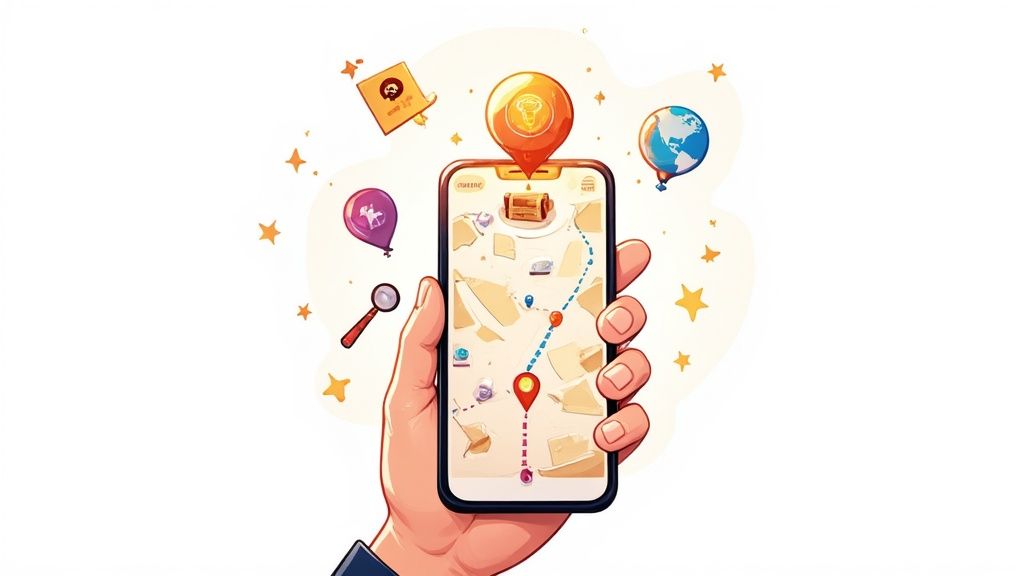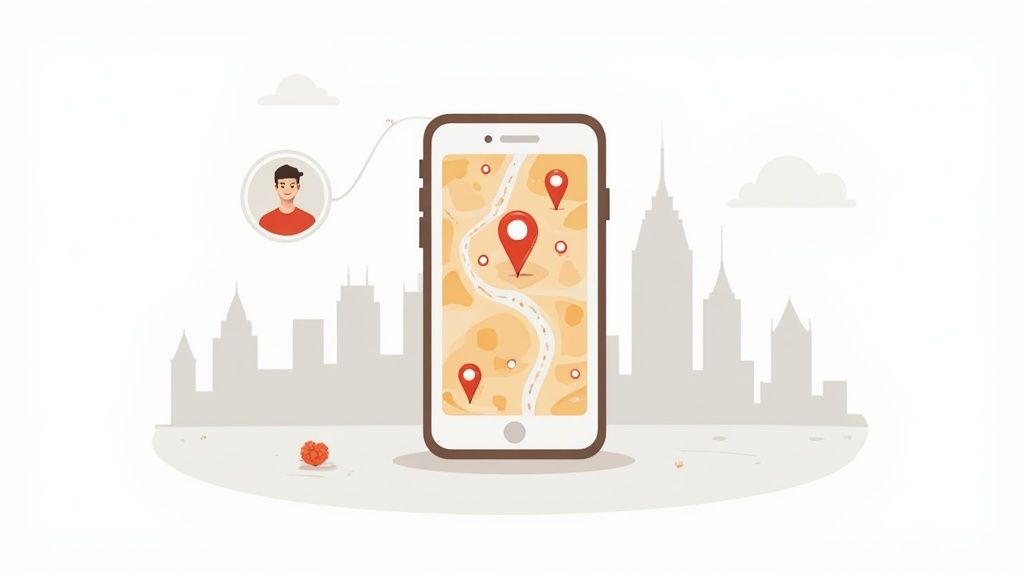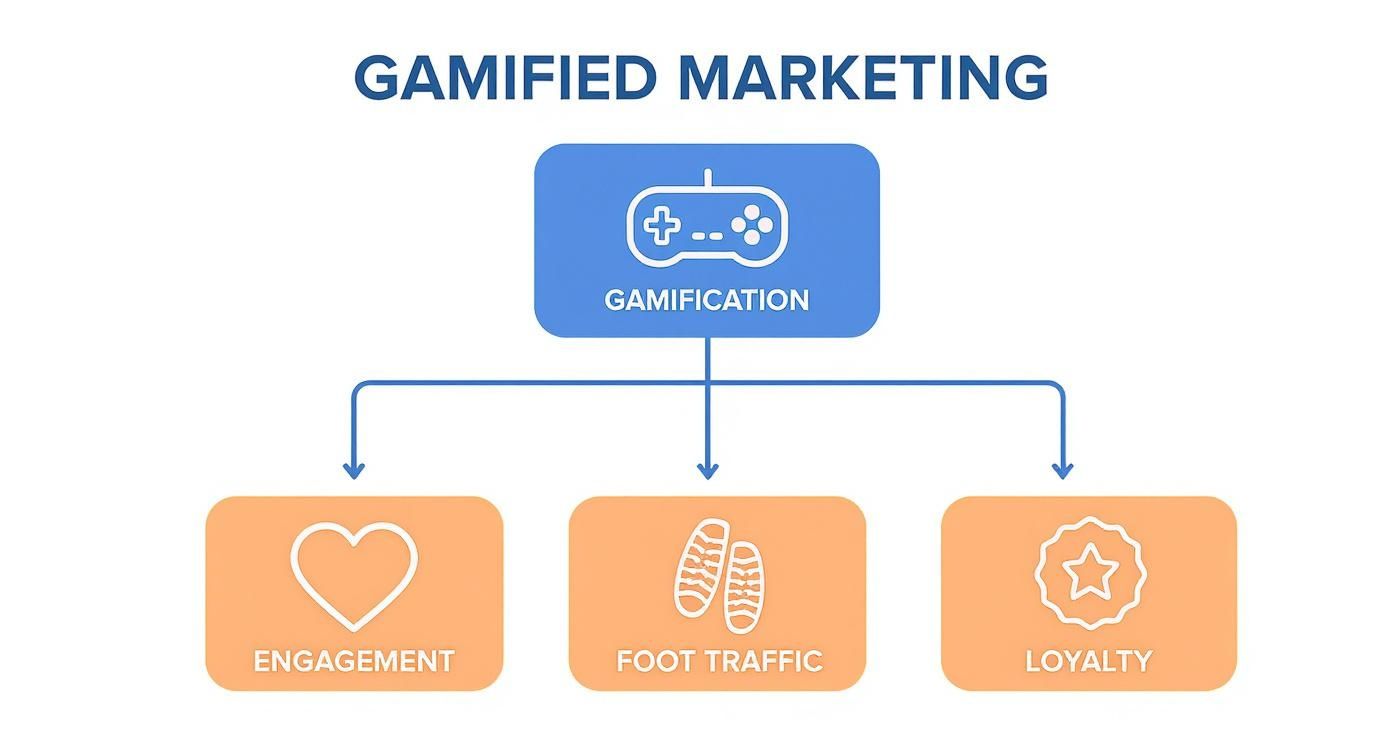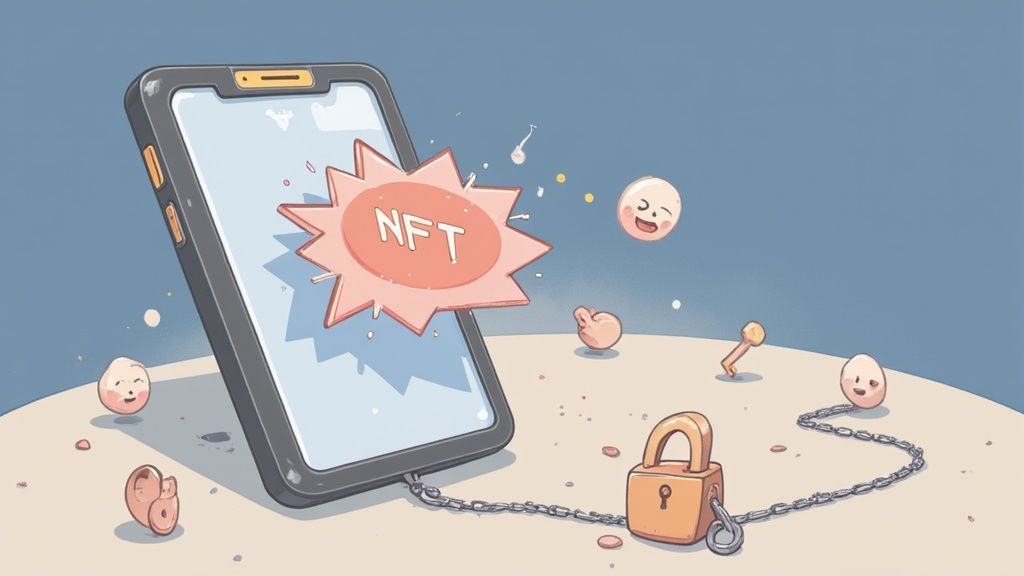Build a Winning Treasure Hunting App

Remember scavenger hunts? That feeling of excitement, following a crinkled map to find a hidden prize? A treasure hunting app takes that classic adventure and puts it right on your smartphone, turning the real world into an interactive game. Brands use these apps to send you on a quest to find clues, solve puzzles, and win real rewards out in the wild.
What Exactly Is a Treasure Hunting App?

Forget old-school paper clues. A modern treasure hunting app uses your phone's GPS to mix digital puzzles with physical exploration. It can transform any location—a city street, a local shop, or a music festival—into a live-action game board. You’re essentially following digital breadcrumbs from one spot to the next, making a simple errand feel like an epic adventure.
This idea has been around for a while, really taking off with geocaching, which has built a massive worldwide following. Just to give you an idea, geocachers logged over 83.7 million finds in 2022 alone. That's a 16% jump from the year before, which shows people are still hungry for these kinds of location-based games. Today's apps are simply tapping into that same spirit for marketing.
The Modern Adventure Map
It's a lot like Pokémon GO, but instead of catching a Pikachu, you're interacting with a brand. Players might find themselves:
- Scanning a QR code on a monument to get a cool historical tidbit.
- Answering a trivia question about a product while standing inside the store.
- Snapping a selfie in front of a sponsored mural to score points.
The whole point is to create something that feels more like a fun discovery and less like a sales pitch.
A treasure hunting app, at its core, helps users discover and identify valuable items, much like the best antique identification app guides users through uncovering the history and value of their finds. It’s about the thrill of the hunt and the reward of discovery.
This interactive approach gives businesses a brilliant way to drive foot traffic, tell their story, and make a lasting impression on their audience. By turning passive customers into active players, brands build experiences that create real loyalty and buzz. It’s more than just a game; it’s a smart strategy that connects a brand’s digital presence with the physical world.
Why Brands Are Ditching Ads for Adventures
Let's be honest, we're all tired of being bombarded with digital ads. In a world where everyone is shouting, brands are realizing they need a better way to connect. Shouting louder isn't working anymore. The real goal is to invite customers into an experience, and that’s where a treasure hunting app completely flips the script.
Instead of just pushing a sales pitch, brands can now pull customers into a story. This move toward experiential marketing is huge. It turns someone who might just scroll past your ad into an active participant in an adventure. The thrill of the chase creates a positive memory that a banner ad could never hope to achieve, building a genuine connection that makes a brand feel more like a friend than a faceless corporation.
Turning Clicks Into Community
So, how does it work? Gamification is the secret sauce. By sprinkling in game-like features—think points, leaderboards, and cool rewards—brands give people a reason to stick around and get more involved. This isn't just about making things fun; it's smart psychology. It taps right into our human desire for competition, achievement, and, well, winning stuff.
The big idea is to create an experience so genuinely enjoyable that people forget they're even part of a marketing campaign. When someone chooses to participate because it's rewarding, you build real brand loyalty that sticks around long after the hunt ends.
This strategy also kicks off a powerful ripple effect. Players naturally want to share their progress, post selfies with their finds, and brag about their scores online. That's organic, word-of-mouth marketing at its best, because it comes from a source people actually trust: their friends. Suddenly, one person's adventure becomes a recommendation to their entire social circle. If you want to see just how creative brands can get, check out these amazing concepts behind the treasure hunt.
Driving Foot Traffic and Gaining Insights
The perks of a treasure hunting app go way beyond online buzz. For any business with a physical location, these apps are a game-changer for driving real-world foot traffic. A clue hidden in a local cafe or a special offer you can only redeem in-store? That's how you turn digital engagement into actual customers walking through your door.
At the same time, brands collect incredibly useful information without being creepy about it. They can see which locations get the most visitors, which rewards people are most excited about, and how customers are interacting with their brand out in the wild. This kind of data is pure gold for fine-tuning future marketing efforts. From high-fashion brands like Gucci to retail giants like Zara, companies are launching metaverse treasure hunts to build deeper relationships with their customers. By gamifying their marketing, brands create a true win-win: customers get a fun experience they'll remember, and businesses build a dedicated community that actually cares.
Must-Have Features for a Great Treasure Hunt App
A really good treasure hunting app is more than just a bunch of dots on a map. It’s an adventure. It needs to pull players in and keep them hooked from the moment they sign up until they claim that final prize. When you get the mix of features just right, you turn a simple game into a brand experience they won't forget. But if the tech is clunky or the interface is a mess, even the most brilliant campaign will just fall flat.
Building an app that people actually want to use means nailing the essentials while adding a bit of flair. Think of it like a race car. You absolutely need the engine and wheels—that’s non-negotiable. But it's the sleek design and roaring exhaust that get everyone’s attention. Your app needs both the reliable engine and the exciting extras to truly win over your audience.
This diagram breaks down how all the gamified pieces fit together to hit those big marketing goals, like getting people excited and turning them into loyal fans.

As you can see, the whole idea is to use game mechanics to shape what users do, whether that’s driving foot traffic to your store or just building a genuine connection with your brand.
Deciding what to build first can be tough. The table below separates the "must-haves" from the "nice-to-haves" to help you prioritize your app's features for a successful launch.
Essential Features for Your Treasure Hunting App
| Feature Category | Core Functionality (Must-Have) | Advanced Enhancement (Nice-to-Have) |
|---|---|---|
| Mapping & Navigation | A responsive, accurate GPS map that guides users to locations without lag or glitches. | Augmented Reality (AR) overlays that bring clues to life in the real world. |
| Clue & Challenge System | A flexible clue system that supports text, images, and videos to keep things interesting. | Interactive puzzles, QR code scanning, or mini-games integrated into the app. |
| Rewards & Redemption | A secure prize redemption process for claiming digital coupons, NFTs, or physical items. | A tiered prize system with bonus rewards for completing challenges quickly or finding hidden items. |
| User Engagement | Simple push notifications to announce new clues or remind inactive players to rejoin the hunt. | Personalized notifications based on player progress or proximity to a new clue. |
| Social & Community | Basic social sharing buttons for players to post their progress on platforms like X or Instagram. | A live leaderboard that sparks competition and an in-app feed for players to share tips and photos. |
Ultimately, the core features make the app work, but the advanced ones are what make it memorable and shareable. Start with a solid foundation, then add the bells and whistles as you grow.
Core Functionality Your App Needs
Alright, let's talk about the engine of your app—the absolute must-haves. These are the features that make sure the game runs smoothly and doesn't leave players frustrated.
Interactive GPS Map: This is the heart and soul of the whole experience. The map needs to be fast and accurate, guiding people to clues without making them want to throw their phone. A great map makes exploring feel natural, not like a chore.
Flexible Clue System: Let's face it, text-only clues get boring. Your app has to support different kinds of content—images, audio clips, maybe even short videos—to keep the challenges fresh and exciting.
Secure Prize Redemption: What's a treasure hunt without the treasure? You need a rock-solid way for people to claim their rewards, whether it's a digital coupon, a unique NFT, or simple instructions for picking up a prize in-store.
The best treasure hunting apps make the technology feel invisible. Players should be so caught up in the adventure that they forget they're using a complex piece of software. The goal is immersion, not a technical showcase.
Features That Drive Player Engagement
Once you’ve got the basics down, it’s time to add the fun stuff. These are the features that get people talking, create a little friendly competition, and turn a solo activity into a community event. This is how you get your campaign to spread on its own.
A static game gets old fast. Here’s what keeps people coming back:
Real-Time Leaderboards: Nothing fires people up like seeing their name at the top of a list. A live leaderboard encourages everyone to keep hunting and gives them some serious bragging rights.
Social Sharing Integration: Make it effortless for players to show off. A simple button to post a selfie with a clue they just found or to share their ranking on social media is basically free advertising for your campaign.
Push Notifications: Use these strategically. A well-timed notification can bring a player back into the game, alert them to a new clue drop, or announce a surprise bonus challenge. It's your direct line to keeping the hunt on their mind.
Using NFTs and Web3 to Reward Your Players

This is where traditional marketing gets a serious upgrade. A treasure hunting app is the perfect way to bring your audience into the world of Web3. It feels exciting and natural, not like you're forcing some complicated tech on them. Instead of a boring old discount code, just imagine a player finding the final treasure and getting a unique digital collectible for their efforts.
That’s the core idea behind using Non-Fungible Tokens (NFTs) as rewards. An NFT isn't just some JPEG; it's a provably unique, ownable asset recorded on the blockchain. When a player finds a treasure, they're not just winning—they're getting a digital trophy from a real-world adventure. That turns a quick moment of victory into something they can actually keep in their crypto wallet.
Turning Tries Into Keys
Now for the really cool part: what if those digital trophies could unlock new experiences? This is a concept called token-gating, and it basically means owning a specific NFT works like a cryptographically-secured VIP pass.
This adds a whole new dimension to your campaign. A brand could create a multi-part treasure hunt where finding the first NFT is the only way to get the clues for the next, even more exclusive stage.
By connecting digital ownership to real perks, you start building a community that's truly invested. The NFT stops being just a prize and becomes proof they were there—a key to a deeper relationship with your brand.
This whole process isn't just about rewarding people; it's about teaching them. They get a hands-on, low-stakes lesson in how crypto wallets and digital ownership work. Offering a free-mint NFT as a prize makes this even better by completely removing the financial barrier to entry. Players can claim their very first digital asset without spending a dime. You can learn more about how powerful this is in our guide to the free mint NFT strategy.
Building a Verifiable Community
Using NFTs also gives you a way to build a community of your most die-hard fans—with proof to back it up. A list of NFT holders isn't like your average email list. It's a group of people who have actively jumped through hoops to engage with your brand.
This opens up some incredible doors for future marketing. You could airdrop exclusive offers straight to their wallets or give them first dibs on new products.
Here’s how this completely changes the community-building game:
- Verifiable Loyalty: Since ownership is public on the blockchain, you can see exactly who your biggest supporters are.
- Direct Communication: You can skip the social media algorithms and interact directly with holders through their wallets.
- Ongoing Value: The NFT doesn't have to be a one-and-done thing. It can gain new perks and utility over time, keeping your community hooked long after the hunt ends.
At the end of the day, weaving Web3 rewards into your treasure hunt isn't just some gimmick. It's a smart strategy for building a more loyal, engaged, and modern community around your brand.
How to Launch Your App Without Writing Code
Think you need a massive budget and a whole team of developers to launch your own treasure hunting app? Think again. That’s the old, slow way of doing things. Today, you don't need to be a coding genius to bring an awesome interactive marketing campaign to life.
The game has completely changed, thanks to powerful no-code toolkits. These platforms are basically like building with LEGOs instead of trying to engineer something from scratch. They give you all the essential pieces—maps, clue systems, reward management—and let you just snap them together with a simple drag-and-drop interface.
This whole approach puts the power right back into your hands. It lets you focus on the fun, creative side of your campaign instead of getting bogged down in the complex code running behind the scenes.
Design Your Adventure in Minutes
The process is surprisingly simple and, honestly, pretty fun. You kick things off by designing the look and feel of your app to perfectly match your brand’s vibe. From there, you just start plotting out the adventure.
- Set Your Locations: Just drop pins on a digital map to mark where your clues will be. They could be in a physical store, a city park, or even hidden on different pages of your website.
- Create Engaging Clues: Write your puzzles, upload images, or even link out to videos. The system takes care of all the logic, automatically unlocking the next clue once a player solves the current one.
- Define the Rewards: Figure out what players will win. You can easily set up digital rewards like discount codes, exclusive content, or unique NFTs that get sent to winners the moment they finish.
You can manage this entire experience from a single, intuitive dashboard. Watch how many people are playing, track their progress in real-time, and even make tweaks on the fly without having to call a developer. It's a huge departure from traditional app development, which can drag on for months and cost a small fortune.
The real beauty of no-code is that it makes powerful technology available to everyone. What once required a dedicated tech team is now something any marketer with a great idea can pull off.
This accessibility means you can launch a really cool, sophisticated treasure hunt in a fraction of the time and for a fraction of the cost. It’s a faster, smarter way to build experiences that people actually enjoy.
For a deeper look into how no-code can kickstart your marketing, check out our guide on building a no-code landing page and see how you can apply the same principles to your next interactive campaign. It’s all about working smarter, not harder.
Common Treasure Hunt Hiccups and How to Dodge Them
So, you’ve got a killer idea for a treasure hunt. That’s the fun part. But before you get too far, it's smart to think about the real-world snags that can trip up even the best-laid plans. A little foresight can be the difference between a viral sensation and a frustrating flop for your players.
Don't Let Tech Get in the Way
First up, let’s talk tech. Your biggest potential headache? GPS accuracy. We've all seen that little blue dot on our maps jump around. In a city canyon surrounded by skyscrapers or even just a park with dense trees, GPS signals can get wonky. This can send a player 20 feet away from your hidden clue, turning a fun challenge into an impossible task.
To get around this, you can make your "find zones" a bit more generous in these tricky spots. Another pro tip is to add a visual hint—a photo of a unique bench or a weird-looking tree—to help guide them when the tech gets squirrelly.
Safety Isn't a Side Quest, It's the Main Quest
Next, we have to talk about player safety. When you're sending a crowd of people out into the world, you have a responsibility to keep them out of trouble. Think carefully about your route. Are you accidentally leading them across a six-lane highway or onto someone's private lawn? What about sending them into a dimly lit alley after dark?
It sounds simple, but laying out some clear safety guidelines right in the app is a must. A little common sense goes a long way.
The Art of the "Just Right" Puzzle
Crafting the perfect puzzle is a real art form. You're aiming for that sweet spot—challenging enough to make someone feel clever, but not so hard they just give up and go home. What seems obvious to you as the creator can be a total head-scratcher for your audience.
You're trying to get players into a "flow state," that perfect zone where they feel challenged but totally capable. Make it too tough, and you'll see people drop off fast. Too easy, and there's no real sense of victory.
How do you nail it? Beta testing. Always, always beta test. Grab a small group of friends or colleagues and have them run through the whole thing. Watch where they struggle, listen to what confuses them, and tweak your clues. A bit of testing upfront saves a mountain of trouble later and makes sure your hunt is actually fun.
Let's not forget, the mobile app space is massive. Consumer spending is projected to rocket to $270 billion by 2025, which shows just how much people love a great app experience. You can dig into more stats about the growing app market on Appstorespy.com. By sidestepping these common issues, you're not just creating a game; you're building an experience that can really stand out.
Got Questions About Treasure Hunting Apps? We've Got Answers.
Jumping into any new marketing strategy can feel a bit overwhelming, and building an app probably sounds like a massive undertaking. But it's way more doable than you might think. Let's tackle some of the most common questions we hear from brands ready to build their own adventures.
First things first, let's talk about the elephant in the room: the budget. Everyone wants to know what this will cost, so let's clear the air and see how this can work for just about any business.
How Much Does It Cost to Build a Treasure Hunting App?
Honestly, the cost can be all over the map. If you decide to go the old-school route and hire a team for custom development, you could easily be looking at tens or even hundreds of thousands of dollars. That path is a long one, filled with endless coding, bug squashing, and the need for a dedicated tech team.
But here’s the good news: using a no-code platform completely flips the script. This approach shatters the financial barrier, putting a full-blown treasure hunting app within reach for a simple monthly fee or a per-campaign cost. You get your idea out into the world faster and at a tiny fraction of the traditional price.
Can a Treasure Hunting App Work for an Online-Only Business?
You bet it can! While a lot of hunts are designed to get people into physical stores, the whole concept is incredibly versatile. An online-only brand can easily create a "digital treasure hunt" that sends users on an expedition across its entire digital footprint.
Think about it—you could hide clues inside:
- Specific blog posts you want people to read
- Product pages on your e-commerce site
- Your latest Instagram stories or TikToks
- Content on a partner's website or an influencer's feed
This kind of hunt takes users on a journey that cranks up your online engagement, keeps them on your site longer, and gets them to truly explore what your brand is all about. And the best part? They don't even have to get off the couch.
What Are the Most Effective Rewards for a Treasure Hunt?
The best prizes are the ones that feel true to your brand and actually get your audience excited. A generic, one-size-fits-all reward just doesn't hit the same. You have to think about what your community genuinely gets fired up about.
We've found that a tiered reward system works wonders for keeping people hooked from start to finish.
Hand out small, instant-win rewards for finding individual clues—things like a quick discount code or a digital collectible. This keeps the momentum going. Then, dangle a much bigger grand prize for the dedicated few who complete the entire hunt. That's what really drives the competition.
Your rewards could be anything from exclusive NFTs and physical products to once-in-a-lifetime experiences that money just can't buy.
Ready to launch your own adventure without the coding nightmare? Domino gives you a powerful no-code toolkit to design, launch, and manage your treasure hunt in minutes. Build your first quest today!
Level Up Your dApps
Start using Domino in minutes. Use automations created by the others or build your own.
